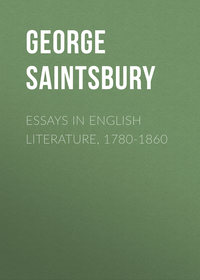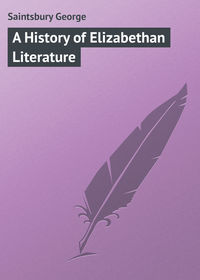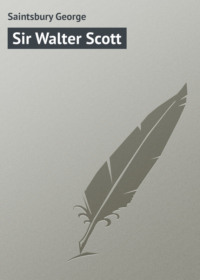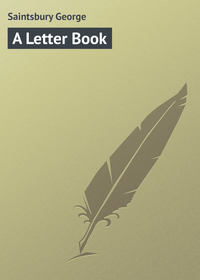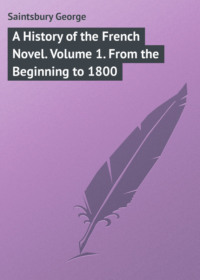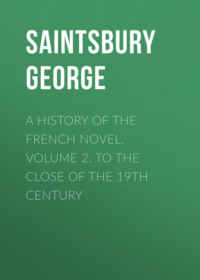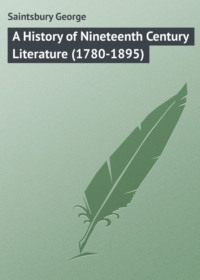 полная версия
полная версияA Short History of French Literature
The following is a list of Racine's theatrical pieces. La Thébaïde, 1664, indicates with sufficient clearness the lines upon which all Racine's plays, save the two last, were to be constructed – a minute adherence to the rules, very careful versification and subordination of almost all other interests to stately gallantry – but it is altogether inferior to its successors. In Alexandre le Grand, 1665, the characteristics are accentuated, and what Corneille disdainfully called —
Le commerce rampant de soupirs et de flammesis more than ever prominent. In Andromaque, 1667, an immense advance is perceptible. The characters become personally interesting (Hermione is perhaps more attractive than any of Corneille's women), and a power of passionate invective not unworthy to be compared with Corneille's, but with more of a feminine character about it, appears. This was followed by Racine's only attempt in the comic sock, Les Plaideurs, 1668, a most charming trifle which has had, and has deserved, more genuine and lasting popularity than any of his tragedies. He returned to tragedy, and rapidly showed the defects of the stereotyped mannerism inevitably imposed on him by his plan. Britannicus, 1669, Bérénice, 1670, Bajazet, 1672, and Mithridate, 1673, with all their perfection of technique, announce, as clearly as anything can well do, the fatal monotony into which French tragedy had once more fallen, and in which it was to continue for a century and a half. Iphigénie, 1674, has much more liveliness and variety, the deep pathos and terror of the situation making even Racine's interminable love casuistry natural and interesting. But Phèdre, 1677, the last of the series, is unquestionably the most remarkable of Racine's regular tragedies. By it the style must stand or fall, and a reader need hardly go farther to appreciate it. Britannicus was indeed preferred by eighteenth-century judges; but for excellence of construction, artful beauty of verse, skilful use of the limited means of appeal at the command of the dramatist, no play can surpass Phèdre; and if it still is found wanting, as it undoubtedly is by the vast majority of critics (including nowadays a powerful minority even among Frenchmen themselves), the fault lies rather in the style than in the author, or at least in the author for adopting the style. Esther, 1689, and Athalie, 1691, on the other hand, while retaining a certain similarity of form and machinery, are radically different from the other plays. It is evident that Racine before writing them had attentively studied the sixteenth-century drama, to the strict form of which with its choruses he returns, and from which he borrows, in some cases directly, the Aman of Montchrestien having clearly suggested passages in Esther. His great poetical faculty has freer play; he escapes the monotonous 'soupirs et flammes' altogether, and the result is in Esther on the whole, in Athalie wholly, admirable.
Racine's peculiarities as a dramatist have been already indicated, but may now be more fully described. He was emphatically one of those writers – Virgil and Pope are the other chief notable representatives of the class – who, with an incapacity for the finest original strokes of poetry, have an almost unlimited capacity for writing from models, for improving the technical execution of their poems, and for adjusting the conception of their pieces to their powers of rendering. These writers are always impossible without forerunners, and not usually possible without critics of the pedagogic kind. Racine was extraordinarily fortunate in his forerunner, and still more fortunate in his critic. He was able to start with all the advantages which thirty years of work on the part of his rival, Corneille, gave him; and he had for his trainer, Boileau, one of the most capable, if one of the most limited and prejudiced, of literary schoolmasters. Boileau was no respecter of persons, and arrogant as he was, he was rather an admirer of Racine than of Corneille; yet, according to a well-known story, he distinguished between the two by saying that Corneille was a great poet, and Racine a very clever man, to whom he himself had taught the knack of easy versification with elaborate rhyming. It is indeed in his versification that both the strength and the weakness of Racine lie, and in this respect he is an exact analogue to the poets mentioned above. He treated the Alexandrine of Corneille exactly as Pope treated the decasyllable of Dryden, and as Virgil treated the hexameter of Lucretius. In his hands it acquired smoothness, softness, polish, and mechanical perfections of many kinds, only to suffer at the same time a compensatory monotony which, when the honied sweetness of it began to cloy, was soon recognised as a terrible drawback. The extraordinary estimation in which Racine is held by those who abide by the classical tradition in France depends very mainly on the melody of his versification and rhymes, but it does not depend wholly upon this. There must also be taken into account the perfection of workmanship with which he carries out the idea of the drama which he practised. What that ideal was must therefore be considered.
It must be remembered that the object of the French drama of Racine's time was not in the least to hold the mirror up to nature. The model which, owing to admiration of the classics, the Pléiade had almost at haphazard followed, rendered such an object simply unattainable. The so-called irregularity of the English stage, which used to fill French critics with alternate wonder and disgust, is nothing but the result of an unflinching adherence to this standard. It is impossible to reproduce the subtilitas naturae in its most subtle example – the character of man – without introducing a large diversity of circumstance and action. That diversity in its turn cannot be produced without a great multiplication of characters, a duplication or triplication of plot, and a complete disregard of pre-established 'common form.' Now this 'common form' was the essence of French tragedy. Following, or thinking that they followed, the ancients, French dramatists and dramatic critics adopted certain fixed rules according to which a poet had to write just as a whist-player has to play the game. There was to be no action on the stage, or next to none, the interest of the play was to be rigidly reduced to a central situation, subsidiary characters were to be avoided as far as possible, the only means afforded to the personages of explaining themselves was by dialogue with confidantes – the curse of the French stage – and the only way of informing the audience of the progress of the action was by messengers. Corneille accepted these limitations partially, and without too much good-will, but he evaded the difficulty by emphasising the moral lesson. The ethical standard of his plays is perhaps higher on the whole than that of any great dramatist, and the wonderful bursts of poetry which he could command served to sugar the pill. But Racine was not a man of high moral character, and he was a man of great shrewdness and discernment. He evidently distrusted the willingness of audiences perpetually to admire moral grandeur, whether he did or did not hold that admiration was not a tragic passion. Probably he would have put it that it was not a passion that would draw. Love-making, on the contrary, would draw, and love-making accordingly is the staple of all his plays. But the defect which has attended all French literature, which was aggravated enormously by this style of drama, and which is noticeable even in his greater contemporaries, Corneille and Molière, manifested itself in his work almost inevitably. If there is one fault to be found with the creations of French literary art, it is that they run too much into types. It has been well said that the duty of art is to give the universal in the particular. But to do this exactly is difficult. It is the fault of English and of German literature to give the particular without a sufficient tincture of the universal, to lose themselves in mere 'humours.' It is the fault of French literature to give the type only without differentiation. An ill-natured critic constantly feels inclined to alter the lists of Racine's dramatis personae, and instead of the proper names to substitute 'a lover,' 'a mother,' 'a tyrant,' and so forth. So great an artist and so careful a worker as Racine could not, of course, escape giving some individuality to his creations. Hermione, Phèdre, Achille, Bérénice, Athalie, are all individual enough of their class. But the class is the class of types rather than of individuals. After long debate this difference has been admitted by most reasonable French critics, and they now confine themselves to the argument that the two processes, the illustration of the universal by means of the particular, and the indication of the particular by means of the universal, are processes equally legitimate and equally important. The difficulty remains that, by common consent of mankind – Frenchmen not excluded – Hamlet, Othello, Falstaff, Rosalind, are fictitious persons far more interesting to their fellow-creatures who are not fictitious than any personages of the French stage. There is, moreover, a simple test which can be applied. No one can doubt that, if Shakespeare had chosen to adopt the style, and had accepted the censorship of a Boileau, he could easily have written Phèdre. It would be a bold man who should say that Racine could, with altered circumstances but unaltered powers, have written Othello.
Minor Tragedians.
The style of tragedy which was likely to be successful in France had been pointed out so clearly by Corneille and by Racine that it could not fail to find imitators. As usual, the weakness of the style was more fully manifested by these imitators than its strength. The best of them was Thomas Corneille, the younger brother of Pierre. A much more facile versifier than his brother, he produced a large number of plays, of which Camma, Laodice, Ariane, Le Comte d'Essex, have considerable merit. Thomas Corneille succeeded his brother in the Academy, and died at a great old age. He was an active journalist and miscellaneous writer as well as a dramatist, and his principal misfortune was that he had a brother of greater genius than himself. Pradon, whose success against Phèdre so bitterly annoyed Racine, was a dramatist of the third, or even the fourth class, though he enjoyed some temporary popularity. Campistron, a follower rather than a rival of Racine, was a better writer than Pradon, but pushed to an extreme the softness and almost effeminacy of subject and treatment which made Corneille contemptuously speak of his younger rival and his party as 'les doucereux.' Quinault, before writing good operas and fair comedies, wrote bad tragedies. The only other authors of the day worth mentioning are Duché and Lafosse. Lafosse is a man of one play, though as a matter of fact he wrote four. In Manlius he gave Roman names and setting to the plot of Otway's Venice Preserved, and achieved a decided success.
Development of Comedy.
The history of French comedy is remarkably different from that of French tragedy. In the latter case a foreign model was followed almost slavishly; in the former the actual possessions of the language received grafts of foreign importation, and the result was one of the capital productions of European literature. Whether the popularity of the indigenous farce of itself saved France from falling into the same false groove with Italy it is not easy to say, but it is certain that at the time of the Renaissance there was some danger. At first it seemed as if Terence was to serve as a model for comedy just as Seneca served as a model for tragedy. The first comedy, Eugène, is strongly Terentian, though even here a greater freedom of movement, a stronger infusion of local colour is observable than in Didon or Cléopâtre. So, too, when the Italian Larivey adapted his remarkable comedies the vernacular savour became still stronger. Yet it was very long before genuine comedy was produced in France. The farces continued, and kinds of dramatic entertainment, lower even than the farce, such as those which survive in the work of the merry-andrew Tabarin239, were relished. The Spanish comedy, with its strong spice of tragi-comedy, was imitated to a considerable extent. A few examples of the Commedia erudita, or Terentian play, continued to be produced at intervals; and the stock personages of the Commedia dell'arte, Harlequin, Scaramouch, etc., at one time invaded France, and, under cover of the comic opera and the Foire pieces, made something of a lodgment. In the earlier years of the seventeenth century, moreover, a considerable number of fantastic experiments were tried. We have a Comédie des Proverbes, in which the action is altogether subordinate to the introduction of the greatest possible number of popular sayings; a Comédie des Chansons spun out of a vast and precious collection of popular songs; a Comédie des Comédies, which is a cento made up of extracts from Balzac, the moralist and letter-writer; a Comédie des Comédiens, in which the famous actors of the day are brought on the stage in their own persons240, etc., etc. While French comedy was thus endeavouring to find its way in all manner of tentative and sometimes grotesque experiments, dramatists of talent occasionally struck, as if by accident, into some of the side paths of that way, and directed their successors into the way itself. The early comedies of Corneille have been spoken of; despite the improbability of their Spanish plots, they show a distinct feeling after real excellence. The eccentric Cyrano de Bergerac, especially in his Pédant Joué, furnished Molière with hints, and displayed considerable comic power. Scarron, a not dissimilar person, whose Roman Comique shows the interest he felt in the theatre, also wrote comedies, the chief of which were extremely popular, the character of Jodelet in the play of the same name (1645) becoming for the time a stock one both in name and type. Scarron's other chief pieces were Don Japhet d'Arménie, L'Héritier ridicule, La Précaution inutile. It was in the Menteur of Corneille that Molière himself considered that true comedy had been first reached, and it was this play which set him on the track. But French comedy of the seventeenth century, before Molière, is one of the subjects which have hardly any but a historical and antiquarian interest. Although far less artificial than contemporary tragedy, it is inferior as literature. It was attempted by writers of less power, and it is disfigured by too frequent coarseness of language and incident. It was on the whole the lowest of literary styles during the first half of the century. With Molière it became at one bound the highest.
Molière.
Jean Baptiste Poquelin241, afterwards called Molière, was born at Paris, probably in January 1622, in the Rue St. Honoré. The Poquelin family seem to have come from Beauvais. Some hypotheses as to a Scotch origin have been disproved. Molière's father was an upholsterer, holding an appointment in the royal household, and of some wealth and position. Molière himself had every advantage of education, being at school at the famous Jesuit Collége de Clermont, and afterwards studying philosophy (under Gassendi) and law. He was, according to some accounts, actually called to the bar. At his majority he seems to have received a considerable share of his mother's fortune, and thus to have become independent. He joined some other young men of fair position in establishing a theatrical company called L'Illustre Théâtre, which, however, failed with heavy loss to him, notwithstanding the assistance of a family of professional actors and actresses, one of whom, Madeleine Béjart, figures prominently in his private history. He was not to be thus disgusted with his profession. In 1646 he set out on a strolling tour through the provinces, and was absent from the capital for nearly thirteen years. The notices of this interesting part of his career which exist are unfortunately few, and, like many other points connected with it, have given rise to much controversy. It is sufficient to say that he returned to Paris in 1658, and on the 24th of October performed with his troupe before the court. He had long been a dramatist as well as an actor, and had written besides minor pieces, most of which are lost, the Étourdi and the Dépit Amoureux. Molière soon acquired the favour of the king, and the Précieuses Ridicules, the first of his really great works, gained for him that of the public. In 1662 he married Armande Béjart, the younger sister of Madeleine – a marriage which brought him great unhappiness, though it was probably not without influence on some of his finest work. The king was godfather to the first child of the marriage, and Molière was a prosperous man. He became valet-de-chambre to Louis, and it was some insolence of his noble colleagues which is alleged, in a late and improbable though famous story, to have occasioned the incident of his partaking of the king's en cas de nuit. The highest point of his genius was shortly reached; Tartuffe, the Festin de Pierre, and Le Misanthrope being the work of three successive years, 1664-6. Tartuffe brought him some trouble because it was supposed to be irreligious in tendency, or at least to satirise the profession of religion. These, his three greatest comedies, were not all warmly received, and he fell back upon lighter work, producing in rapid succession farce-comedies for the public theatre, and divertissements of divers kinds for the court until his death in February 1673, which happened almost on the stage.
The following is a complete list of Molière's work which has come down to us. During his provincial sojourn he had written many slight pieces half-way in kind between the Italian comedy and the native farce. Of these two only survive, Le Médecin Volant and La Jalousie du Barbouillé. Both have considerable merit, and Molière subsequently worked up their materials, as no doubt he did those of the lost pieces. L'Étourdi, 1653, is a regular comedy in five acts, still strongly Italian in style and somewhat improbable in circumstances, but full of sparkle and lively action and dialogue. Le Dépit Amoureux, 1654, is even better and more independent. Nothing had yet been seen on the French stage so good as the quarrels and reconciliation of the quartette of master, mistress, valet, and soubrette. But Les Précieuses Ridicules, 1659, struck an entirely different note. The stage had been employed often enough for personal satire, but it had not yet been made use of for the actual delineation and criticism of contemporary manners as manners and not as the foibles of individuals. The play was directed against the affectations and unreal language of the members of literary coteries which, with that of the Hôtel Rambouillet as the chief, had long been prominent in French society. It has but a single act, but in its way it has never been surpassed either as a piece of social satire or a piece of brilliant dialogue illustrating ludicrous action and character. Sganarelle, 1660, relapses into the commonplaces of farce, and has no moral or satirical intention, but is amusing enough. Don Garcie de Navarre, 1661, may be called Molière's only failure. He styles it a comédie héroïque, and it is in fact a kind of anticipation of Racine's manner, but applied to less serious subjects. The jealousy of the hero is, however, the only motive of the piece, and its exhibition is rather tiresome than anything else. The play is monotonous and unrelieved by action. The genius of the author reappeared in its appropriate sphere in L'École des Maris (same date), where a Terentian suggestion is adapted and carried out with the greatest skill. Then, still in the same prolific year, Molière returned to social satire in Les Fâcheux, an audacious lampoon on the forms of fashionable boredom common among the courtiers of the time. In 1662 appeared L'École des Femmes, which is generally considered the best of Molière's plays before Tartuffe. A certain slyness about the character of Agnes is its only drawback. This gave occasion to the brilliant and most amusing Critique de L'École des Femmes, 1663. Here the author is once more the satirist of contemporary society, which he introduces as criticising his own work. L'Impromptu de Versailles (same date), according to a curious habit which Molière did not originate, brings the author himself and his troupe in their own names and persons before the spectator. Le Mariage Forcé, 1664, a slight piece, was worked up into a ballet for the court. La Princesse d'Elide (same date) is Molière's most important court piece, or comédie-ballet, and, though necessarily artificial, has great beauty. Next in point of composition came The Hypocrite, that is to say Tartuffe, but the difficulties which this met with made Le Festin de Pierre, 1665, appear first. This is a tragi-comic working up of the Don Juan story, and is of a different class from any other of Molière's comedies. It has been thought, but without sufficient ground, that Molière here gave expression to a modified form of the freethinking which was so common at the time. It may, perhaps, be more truly regarded as an excursion into romantic comedy – the comedy which, like Shakespeare's work, is not directly satiric on society or on individuals, but tells stories poetically and in dramatic form with comic touches. It is noteworthy that Don Juan is of all Molière's heroes least exposed to the charge of being an abstraction rather than a man. The pleasant trifle, L'Amour Médecin (same date), was succeeded by Le Misanthrope, 1666. Here Molière's special vein of satire was worked most deeply and to most profit, though the reproach that the handling is somewhat too serious for comedy is not undeserved. Alceste the impatient but not cynical hero, Célimène the coquette, Oronte the fop, Éliante the reasonable woman, Arsinoé the mischief-maker, are all immortal types. The admirable farce-comedy of the Médecin malgré Lui (same date), founded upon an old fabliau, followed, and this was succeeded almost immediately by the graceful pastoral of Mélicerte, the amusing Pastorale Comique, and the slight sketch of Le Sicilien, ou L'Amour Peintre. At last, in 1667, Tartuffe got itself represented. It is a vigorous and almost ferocious satire on religious pretension masking vice, and many of its separate strokes are of the dramatist's happiest. Here however, more than elsewhere, is felt the drawback of the method. Comparing Tartuffe with Iago, we have all the difference between a skilful but not wholly probable presentation of wickedness in the abstract, and a picture of a wicked man. In Amphitryon, 1668, Molière measured himself with Plautus and produced an admirable play. George Dandin (same date), the working up of La Jalousie du Barbouillé, is one of the happiest of his sketches of conjugal infelicity. Then came L'Avare (same date), in which Molière was once more indebted to the ancients and to his French predecessors, but in which he amply justified his borrowings. At this time he extended his field and brought his knowledge of provincial and bourgeois life to bear. M. de Pourceaugnac, 1669, is an ingenious satire, pushed to the verge of burlesque and farce, on the country squires of France. Les Amants Magnifiques, 1670, shows the writer once more in his capacity of court playwright. But Le Bourgeois Gentilhomme (same date) is the most audacious and by far the most successful of the wonderful extravaganzas in which a sound and perennial motive of satire on society is wrapped up, the theme this time being the bourgeoisie of Paris, of which the author was himself a member. Psyché, 1671, is, perhaps, the most remarkable example of collaboration in literature, Molière, Pierre Corneille, and Quinault, the greatest comic dramatist, the greatest tragic dramatist, and the greatest opera librettist of the day, having joined their forces with a result not unworthy of them. Les Fourberies de Scapin (same date) is again farce, but farce such as only Molière could write; and in La Comtesse d'Escarbagnas (same date) the theme of M. de Pourceaugnac is taken up with a certain heightening of colour and manner. Les Femmes Savantes, 1672, brings the reader back to what is as emphatically 'la bonne comédie' as its original Les Précieuses Ridicules. The tone and treatment are more serious than in the older piece and deal with a different variety of feminine coxcombry, but the effect is not less happy, and is free from the broader elements of farce. Lastly, Le Malade Imaginaire, 1673, the swan-song of Molière, combined both his greatest excellences, the power of raising audacious farce into the region of true comedy and the power of satirising social abuses with a pitiless but good-humoured hand. The main theme here is the absurdity of the current practice of medicine, but as usual the genius of the writer veils the fact of the drama being a drama with a purpose.




